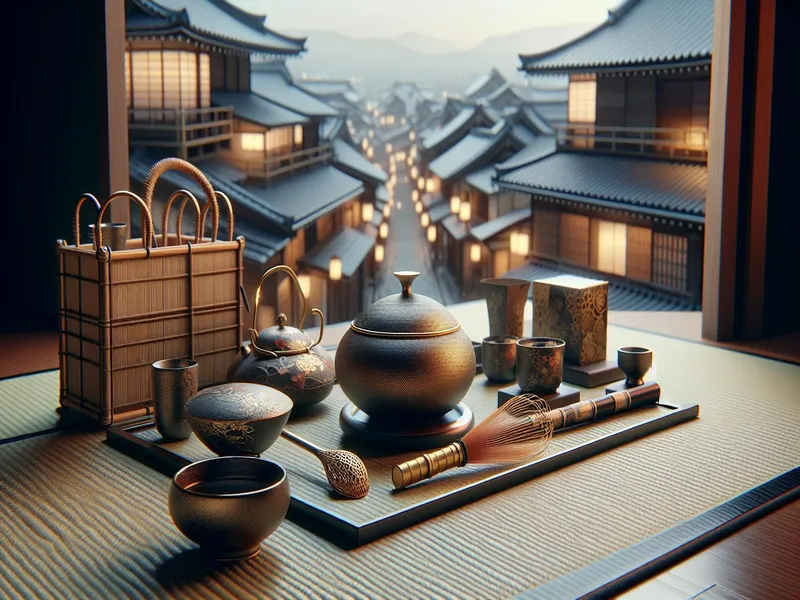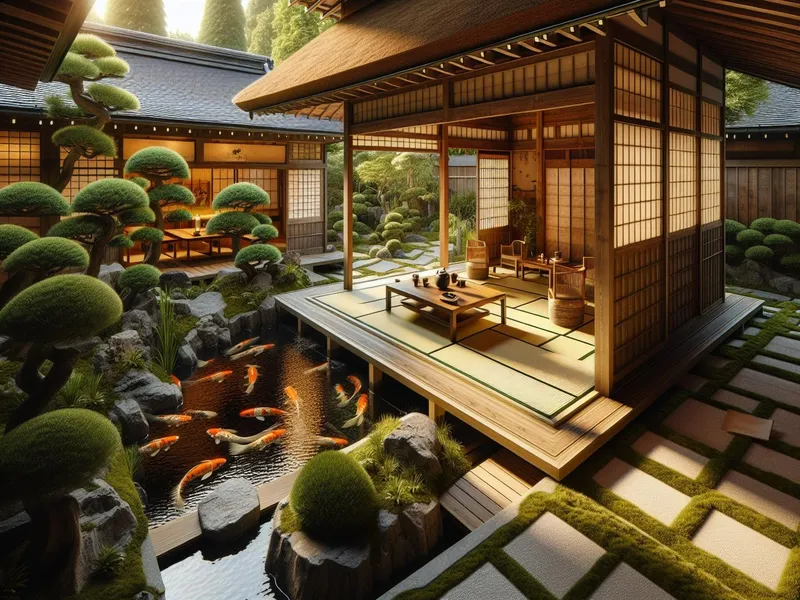the serenity of a Japanese tea ceremony in Tokyo. Experience rich cultural heritage, historical insights, and tranquil escapes perfect for backpacking travelers.

Historical Background
You know, the Japanese tea ceremony isn’t just about sipping tea—it’s a whole vibe steeped in history. It all started way back in the 9th century when Buddhist monks brought tea from China to Japan. These guys weren’t just into meditation; they were all about that zen lifestyle, and tea became a big part of their rituals.
Fast forward to the 16th century, and this is where things get really interesting. Enter Sen no Rikyū—a name you’ll hear a lot if you jump into Japanese culture. This dude revolutionized the tea ceremony, turning it into an art form that’s still practiced today. He emphasized simplicity, humility, and mindfulness—core principles that define the ceremony even now.
Fun Fact: Did you know that each element of the tea room has symbolic meaning? For example:
- Tokonoma (alcove): Displays art or flower arrangements
- Chaji (full-length ceremony): Takes about four hours
- Wabi-sabi: Celebrates beauty in imperfection
Tokyo’s got some rad spots where you can experience this slice of history firsthand. Imagine stepping into a traditional tea house right amidst Tokyo’s hustle and bustle—it’s like hitting pause on life for a moment of pure tranquility.
When I first attended one of these ceremonies in Tokyo, it felt like stepping back in time. The host’s meticulous movements made me appreciate every detail—from how she folded her kimono sleeves to how she whisked the matcha powder with such finesse.
| Aspect | Traditional Ceremony | Modern Interpretation |
|---|---|---|
| Duration | Can last several hours | Often condensed to fit busy schedules |
| Location | Traditional tatami rooms | Cafes or cultural centers |
| Attire | Kimono | Casual wear often accepted |
If you’re backpacking through Japan on a budget but still want to soak up some culture, here’s a quick tip: many cultural centers offer affordable or even free sessions for tourists! You don’t need fancy attire; just bring an open mind and maybe your camera for those Insta-worthy shots .
So next time you’re wandering around Tokyo wondering what to do between temple-hopping and sushi-eating, consider diving deep into Japan’s rich history with a tea ceremony. It’s not just an activity—it’s an experience that’ll stay with you long after you’ve left the land of the rising sun.
Core Elements of the Ceremony

Exploring a Japanese tea ceremony in Tokyo? Awesome choice! It’s like stepping into another world, full of tradition, beauty, and mindfulness. Let’s jump into what makes this ceremony so special.
Tea Types and Varieties
Matcha is usually the star here. This powdered green tea isn’t just any old beverage; it’s deeply rooted in Japanese culture. There’s usucha (thin tea) and koicha (thick tea). Usucha has a lighter, frothy texture while Koicha is more intense—think espresso but with green vibes.
You might also encounter seasonal flavors or different grades of matcha. The higher the grade, the smoother and more vibrant it tastes. If you’re lucky, you could try some rare varieties exclusive to certain regions. Ever had matcha that tasted like fresh grass on a spring morning? That’s Japan for you!
Utensils and Tools
The tools used are almost as fascinating as the ceremony itself:
- Chawan (Tea Bowl): Each one’s unique in design.
- Chasen (Bamboo Whisk): Handcrafted to perfection.
- Chashaku (Tea Scoop): A slender bamboo scoop for precise measurements.
- Natsume or Chaire (Tea Caddy): Stores the precious matcha powder.
These tools aren’t just functional—they’re works of art themselves. Imagine using a whisk made from 100 tiny bamboo prongs! It’s no wonder they treat these utensils with so much respect.
Rituals and Etiquette
Let’s talk rituals: Bowing when entering the room shows respect for both host and space. Shoes off at the door—always keep those socks clean! You’ll see slow, deliberate movements; every action has meaning.
Sipping your tea involves turning the bowl before drinking—a nod to appreciating its craftsmanship. And remember: slurping isn’t rude here! It indicates enjoyment.
Ever felt awkward not knowing how to act? Don’t worry; hosts usually guide you through each step with gentle cues. They want you to feel comfortable while experiencing something truly special.
So there you have it! Those are some core elements that make up this beautiful ritual called chanoyu—the Japanese tea ceremony. Whether you’re backpacking through Tokyo or staying awhile, taking part in this experience will leave an indelible mark on your journey.
Notable Tea Houses in Tokyo

Exploring Tokyo’s tea houses is like stepping into a serene world away from the city’s hustle and bustle. Each tea house offers its own unique experience, making it worth visiting multiple spots if you have time.
Kagurazaka Saryo
Kagurazaka Saryo sits in the trendy Kagurazaka district, known for its charming narrow streets and historic vibe. This place combines traditional aesthetics with modern touches, creating a cozy yet sophisticated atmosphere. Picture this: you’re sitting on tatami mats, sipping matcha while gazing at a beautiful garden view.
- Location: Kagurazaka
- Specialty: Seasonal wagashi (Japanese sweets) paired with matcha
- Highlight: Outdoor seating area with traditional Japanese garden
I’ve found that Kagurazaka Saryo attracts both locals and tourists looking for an authentic yet accessible tea experience. If you visit during sakura season, the cherry blossoms add an extra layer of magic to your visit .
Happo-en
Happo-en is more than just a tea house—it’s a whole cultural experience nestled in Shirokanedai. The name means “Garden of Eight Views,” which perfectly captures the panoramic beauty you’ll find here. Imagine walking through meticulously manicured gardens before entering a serene tea room where every detail has been thoughtfully curated.
- Location: Shirokanedai
- Specialty: Traditional tea ceremonies led by experienced hosts
- Highlight: 500-year-old bonsai trees and koi ponds
When I visited Happo-en, I felt like I’d stepped back in time. The harmony between nature and architecture here makes it one of my favorite spots in Tokyo for soaking up tranquility amidst urban chaos.
Hamarikyu Gardens
Hamarikyu Gardens offer a historical twist as they were once part of feudal Lord Tokugawa’s estate. Located near Tsukiji Market, it’s an oasis surrounded by skyscrapers—a striking contrast that’s uniquely Tokyo! After exploring the vast parklands filled with seasonal flowers and tidal ponds, make your way to Nakajima-no-Ochaya teahouse for some freshly whisked matcha.
- Location: Near Tsukiji Market
- Specialty: Matcha served with views over tranquil waters
- Highlight: Tidal ponds reflecting changing seasons
I remember enjoying my tea here while watching city life buzz around me from afar—it was surreal! Plus, if you’re into photography , Hamarikyu Gardens provide perfect frames blending nature and urbanity effortlessly.
By visiting these notable tea houses in Tokyo , not only do you get to enjoy delicious teas but also immerse yourself deeply into Japan’s rich cultural world woven through centuries-old traditions.
How to Participate in a Tea Ceremony
Experiencing a Japanese tea ceremony in Tokyo is like stepping into another world. You’ll find yourself surrounded by tradition, history, and mindfulness. Here’s how you can join in.
Booking a Session
First things first: booking. Many tea houses require reservations, especially the popular ones. I found that online booking platforms such as Voyagin or direct websites of places like Kagurazaka Saryo work best.
- Online Portals: Websites like Voyagin list multiple venues with user reviews.
- Direct Booking: Tea houses often have their own sites with detailed info.
- Tour Packages: Some tours include tea ceremonies alongside other cultural activities.
Prices vary; expect to pay between ¥2,000 and ¥5,000 (around $20-$50). Some places even offer free sessions if you’re part of a larger group or tour package.
Expected Behavior and Attire
Stepping into a tea room isn’t just about sipping matcha; it’s an immersive experience. First off, let’s talk dress code. Casual clothing is fine but avoid anything too flashy or informal like shorts or flip-flops. Think smart casual—comfortable yet respectful.
When entering the tea room:
- Bow slightly at the entrance.
- Remove your shoes.
- Follow the host’s guidance for seating arrangements.
Etiquette matters here:
- Don’t start drinking until everyone has been served.
- Hold the bowl with both hands when sipping.
- Complimenting the host on the tea’s quality never hurts either!
Benefits of Experiencing a Tea Ceremony
Participating in a Japanese tea ceremony in Tokyo isn’t just about sipping matcha; it’s an enriching experience that offers numerous benefits. Let’s jump into some of the key advantages.
Cultural Insight
Experiencing a tea ceremony gives you profound cultural insight. It’s like stepping into another era where every movement has meaning. When I attended my first ceremony at Kagurazaka Saryo, I learned how each utensil, from the chawan (tea bowl) to the chasen (bamboo whisk), plays a role in telling Japan’s historical narrative.
- Historical Context: The tea ceremony dates back to the 9th century, introduced by Buddhist monks.
- Symbolic Elements: Each element, like the tatami mats and hanging scrolls, symbolizes aspects of Zen philosophy.
It’s fascinating how even simple actions like bowing or sipping tea reflect centuries-old traditions. For instance, did you know that bowing upon entering the room signifies respect for both the host and fellow guests? This level of detail makes you appreciate Japan’s rich culture even more.
Meditative Aspects
The tea ceremony is also incredibly meditative. You find yourself slowing down and focusing on each deliberate movement. I remember sitting in silence during my session at Happo-en, surrounded by lush gardens which added to the tranquility.
- Mindfulness Practice: The slow, deliberate actions promote mindfulness.
- Calming Atmosphere: The serene setting helps reduce stress levels.
Imagine sitting on tatami mats, hearing nothing but the soft whisking sound as your host prepares matcha. It’s almost hypnotic! This peaceful environment encourages you to leave behind modern distractions and fully immerse yourself in the moment.
In Tokyo’s rapid life, participating in such ceremonies can be grounding. You’ll leave feeling rejuvenated and with a deeper appreciation for life’s simple pleasures.
Experiencing a Japanese tea ceremony in Tokyo offers a rare glimpse into Japan’s cultural essence. It’s more than just sipping tea; it’s a journey through history and mindfulness.
I highly recommend adding this enriching experience to your Tokyo itinerary. Whether you’re visiting Kagurazaka Saryo, Happo-en, or Hamarikyu Gardens each venue provides its own unique touch on this timeless tradition.
You’ll leave with not only a deeper appreciation for Japan’s heritage but also a serene state of mind that modern life often disrupts. So take the plunge and immerse yourself in the tranquil beauty of a Japanese tea ceremony—you won’t regret it.